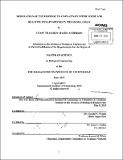| dc.contributor.advisor | Gerald N. Wogan and Luiz C. Godoy. | en_US |
| dc.contributor.author | Anderson, Chase Thaddeus Maceo | en_US |
| dc.contributor.other | Massachusetts Institute of Technology. Department of Biological Engineering. | en_US |
| dc.date.accessioned | 2013-10-24T17:42:18Z | |
| dc.date.available | 2013-10-24T17:42:18Z | |
| dc.date.copyright | 2013 | en_US |
| dc.date.issued | 2013 | en_US |
| dc.identifier.uri | http://hdl.handle.net/1721.1/81673 | |
| dc.description | Thesis (S.M.)--Massachusetts Institute of Technology, Dept. of Biological Engineering, 2013. | en_US |
| dc.description | Title as it appears in MIT Commencement Exercises program, June 2013: Modulation of the ERK1/2 and p53 signaling pathways by nitric oxide during the response to cisplatin in melanoma cells. Vita. Cataloged from PDF version of thesis. | en_US |
| dc.description | Includes bibliographical references (p. 51-58). | en_US |
| dc.description.abstract | Malignant melanoma causes the highest mortality rate in skin cancers. Although cisplatin has proved efficacious in the treatment of various solid tumors, melanoma seems particularly resistant to this chemotherapeutic drug. Reports show that melanoma patients whose tumors express nitric oxide (NO) synthase and/or nitrotyrosine are often faced with poor prognosis. Moreover, it has been shown that NO produced by melanoma cells sustains lower sensitivity to cisplatin toxicity in vitro. Because inflammatory products such as NO and reactive oxygen species (ROS) are associated with the genesis and evolution of cancer, we hypothesized that these oxidative species may regulate key components of the response of melanoma to cisplatin. Using a system for controlled delivery of NO to simulate the NO levels believed to occur during inflammation, we showed that human melanoma (A375) cells pre-exposed to submicromolar NO concentrations were protected from a subsequent challenge with cisplatin. This protection was strongly associated with increased activity of the MAP-kinase cascade leading to activation of ERK1/2, as well as with downstream modulation of the apoptotic factors Bax and Bcl-2, and the transcription factors p53 and MiTF. Although NO favored increased expression and phosphorylation of p53, it also increased the expression of the p53 inhibitor MDM2, which may have counteracted p53-induced apoptosis upon cisplatin treatment. Also, likely via ERK1/2 activation, NO favored phosphorylation of MiTF, which is associated with survival signals. Furthermore, NO displayed the remarkable ability to overcome the effect of U0126, a MEK inhibitor, and promoted continuous phosphorylation of ERK1/2 (and hence cell survival), in contrast to cells not exposed to NO. Results also demonstrated that cisplatin-induced apoptosis was substantially decreased by the antioxidant precursor N-acetylcysteine (NAC). Unlike exogenous NO, cisplatin-induced ROS were linked to lower activation of ERK1/2, which was reversed by NAC. During the treatment with cisplatin, NAC led to lower levels of p53, which may have partially contributed to increased cell survival. However, in contrast to NO, NAC did not significantly alter the effects of cisplatin upon MiTF and apoptotic proteins studied. Altogether, our findings illustrate the complexity of the regulation of signaling components by oxidative species of distinct natures. | en_US |
| dc.description.statementofresponsibility | by Chase Thaddeus Maceo Anderson. | en_US |
| dc.format.extent | 58 p. | en_US |
| dc.language.iso | eng | en_US |
| dc.publisher | Massachusetts Institute of Technology | en_US |
| dc.rights | MIT theses may be protected by copyright. Please reuse MIT thesis content according to the MIT Libraries Permissions Policy, which is available through the URL provided. | en_US |
| dc.rights.uri | http://dspace.mit.edu/handle/1721.1/7582 | en_US |
| dc.subject | Biological Engineering. | en_US |
| dc.title | Modulation of the response to cisplatin by nitric oxide and reactive oxygen species in melanoma cells | en_US |
| dc.title.alternative | Modulation of the ERK1/2 and p53 signaling pathways by nitric oxide during the response to cisplatin in melanoma cells | en_US |
| dc.type | Thesis | en_US |
| dc.description.degree | S.M. | en_US |
| dc.contributor.department | Massachusetts Institute of Technology. Department of Biological Engineering | |
| dc.identifier.oclc | 859911385 | en_US |
